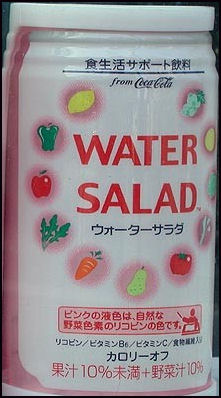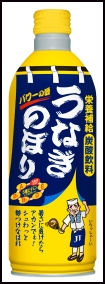SOFT DRINKS IN JAPAN
 Consumption of carbonated soft drinks (2000): 5.4 gallons per person, compared to 55.8 gallons per person in the United States. [Source: Euromonitor International]
Consumption of carbonated soft drinks (2000): 5.4 gallons per person, compared to 55.8 gallons per person in the United States. [Source: Euromonitor International]
The leading soft drink producers in Japan are: 1) Coca Cola; 2) Suntory; 3) Kirin; 4) Ito En; and 5) Asahi. Green tea soft drinks are often the top sellers.
Many Japanese find American-style carbonated drinks and fruit drinks to be too sweet. Pocari Sweat is a popular Gatorade-like sports drink. The Japanese also drink carbonated soft drinks made from milk, burnt rice and barely.
"Near water" drinks, with a touch of fruit flavor and chemically enhanced fizz, are popular in Japan. They have less sugar and fewer calories than carbonated soft drinks and include drinks like Aqua Pear Water, Eau Plus, Pure-In Water, Natural Apple Water, Alkali Ion Water, and Natural Peach Water. The best seller, Suoli, claims to be made of "natural water plus fiber, calcium and vitamins B and C." One company sells a beer "as clear as water" whose name appropriately enough is Beer Water.
Vinegar drinks are popular in Japan. Some drink them like wine. Others, especially women drink them as a health tonics under the belief they will improve circulation, reduce fatigue and induce weight loss. There are soft drinks, shakes, syrup and dessert drinks made with vinegar. In Japan, there are also jelly-like concoctions that are squeezed from tubes like toothpaste and are consumed instead of drinks. Many hikers and sports people consume them.
Inspired by a Japanese book entitled “Dare You to Drink Urine”, many Thais began drinking urine for its purported health benefits in the 1990s. One man who drank his urine told AFP, “Urine is an amazing medicine. Now I drink my urine every morning. I also use it to clean my nasal orifices and help with allergies.” The book claims urine helps clear the mind and can be used to treat and ward off illnesses ranging from a soar throat to AIDS.
Non-alcoholic canned and bottled drink market: tea products, 26.7 percent; canned coffee, 17.1 percent; carbonated rinks, 19.1 percent; near water drinks, 5 percent. Consumption of bottled water (2000): 2.3, compared to 9.5 gallons per person in the United States. [Source: Euromonitor International]
Japanese drinks such as Pocari Sweat and Calpis are popular in Southeast Asia. With drinks sales flat in Japan, Japanese drinkmakers are making a stronger push into Thailand, Indonesia and other countries in the region. Calpis is popular in Thailand while Pocari sweat sells well in Indonesia. Yakult has had success with its “Yakult Lady” sales system in Indonesia.
Good Websites and Sources: Weird Japanese Drinks /inventorspot.com and inventorspot.com/articles ; ; Japanese Soft Drinks instant-ramen.net ; Asian Munchies Drinks asianmunchies.com ; Green Tea Good Photos at Japan-Photo Archive japan-photo.de ; Japanese Green Tea www.o-cha.com ; Japanese Green Tea Online japanesegreenteaonline.com ; teanobi.com ; Links in this Website: DRINKING AND ALCOHOLIC DRINKS IN JAPAN Factsanddetails.com/Japan ;BEER IN JAPAN Factsanddetails.com/Japan ; SAKE AND SOCHU Factsanddetails.com/Japan ; TEA AND NON-ALCOHOLIC DRINKS IN JAPAN Factsanddetails.com/Japan
Japanese Energy Drinks and Kombucha

Noburi eel
energy drink Energy drinks are sold in small bottles mainly to sleepy or hungover salarymen. They have secret formulas of vitamins and proteins, with caffeine often being the chief energizing agent. Energy drinks are big business. There are dozens of drinks all competing for a share of a market worth $1.7 billion a year.
Lipovitan D has been the No. 1 energy drink of since 1962. It sells more than 400 million bottles a year and has a famous series of ads in which two adventurers that help each other out, with an energy lift from the drink, preventing a fatal accident. Lately the sales it and other energy drinks has declined due challenges from Starbucks, ginseng makers and challengers from cheaper energy soft drinks such as Chio
“Kombucha” is a smelly, sour-flavored brownish-colored tea that is said to have a number of health benefits and is said to be made from seaweed. The name “kombucha” means “kelp tea” and it was especially popular in the 1970s. In reality it is not made from seaweed. It is a sweetened, tea fermented by a bacteria and yeast culture that resembles a mushroom. In the United States it is a lightly carbonated sweet, fermented tea that is consumed as an energy drink and said to be able to ward off cancer.
Kombucha is said to have originated in China during the Qin dynasty around 221 B.C. as a healing and digestive aid. It later became popular in Russia and eastern Europe, where it is known as “kvass.” It can be made at home by brewing ordinary tea and sugar and pouring it into a glass jar with a kombucha culture and leaving it covered to ferment for about a week. As it ferments, the kombucha culture reproduces itself in new layers, known as scoby, a symbiotic culture of bacteria and yeast, which are removed for new batches.
Making kombucha at home is tricky. Maintaining proper acidity, temperature and cleanliness are essential. If not the brew can easily be contaminated. For this reason commercial kombucha brands are becoming popular.
Coffee in Japan
A generation ago very few Japanese touched coffee. By the 1980s there were over 100,000 coffee houses. By 2000, coffee had become a $8.12 billion industry with every man, woman and child consuming an average of 331 cups (2001) a year.
Coffee drinking has tripled since 1970 and continues to go up. Bottled and canned coffee accounts for 30 percent of the drink market. The Japanese invented canned coffee drinks. Some Japanese are fond of coffee made with newly-harvested beans.
Starbucks is very fashionable. In 1996 there were no Starbucks in Japan. By 2000 there were more than 200 and plans to open for more than 1,000 by 2004. Starbucks has made big money with small stands in train stations that cater to salarymen on their way to work. In recent years Starbucks dominance has ben challenged by competitors such as Seattle’s Best and Tully’s Coffee.
Both hot and cold canned coffee is popular in Japan. Both kinds are sold in a staggering variety in little cans in vending machines and convenience stores. Popular brands include Wonda, which used Tiger Woods in their advertisements, Georgia, which uses a popular sexy actress dressed in a man’s suit in their ads, and Boss, which used Japan’s most popular singer Ayumi Hamasaki for a while before changing to Tommy Lee Jones.
The Japanese invented canned coffee drinks.
Coffee and Sushi?
Kate Elwood wrote in the Daily Yomiuri: “There is certainly some mixing of cultures” between Japan and the West “ but at the same time, there is often a tidy allocation between the two traditions. Japanese tea goes in Japanese teacups, coffee in Western-style cups and saucers or mugs. Cultural anthropologist Ofra Goldstein-Gidoni in a study entitled “The Making and Marking of the "Japanese" and the "Western" in Japanese Contemporary Culture” somewhat playfully refer to "dangerous liaisons," such as green tea and sandwiches. Goldstein-Gidoni emphasizes that such rules of cultural interface are more strictly adhered to in the public sphere than in private homes. [Source: Kate Elwood, Daily Yomiuri, November 30, 2010]
“The choice of green tea as a symbol of division seems a bit weak, “Elwood writes. “In fact, green tea is Japan's Coke. Decades of slogans for Coca-Cola all seem to fit green tea's role in Japan: "Coca-Cola revives and sustains" (1905); "Thirst asks nothing more" (1939); "Where there's Coke, there's hospitality" (1948); "Things go better with Coke" (1963).”
But while green tea is the "passport to refreshment," to borrow another Coke slogan, Western beverages may have their visas revoked at the point of entry into Japanese culinary territory. Another of Goldstein-Gidoni's examples is coffee and sushi. Oh my! Whether it can be called a "dangerous liaison" or not, that combination certainly goes in the "when pigs fly" category. Even somewhat more palatable mergers such black tea and Japanese wagashi sweets are almost certain to get the designation of awanai (doesn't match). The pairing is not dangerous perhaps, but evokes a sense of fundamental incompatibility.
Image Sources: 1) Doug Mann, Photomann 2) xorsyst blog 3) and 7) JNTO 4) National Museum of Tokyo 5) and 6) Ray Kinnane 8) Coca-Cola 9) Wikipedia
Text Sources: New York Times, Washington Post, Los Angeles Times, Daily Yomiuri, Times of London, Japan National Tourist Organization (JNTO), National Geographic, The New Yorker, Time, Newsweek, Reuters, AP, Lonely Planet Guides, Compton’s Encyclopedia and various books and other publications.
Last updated October 2021
